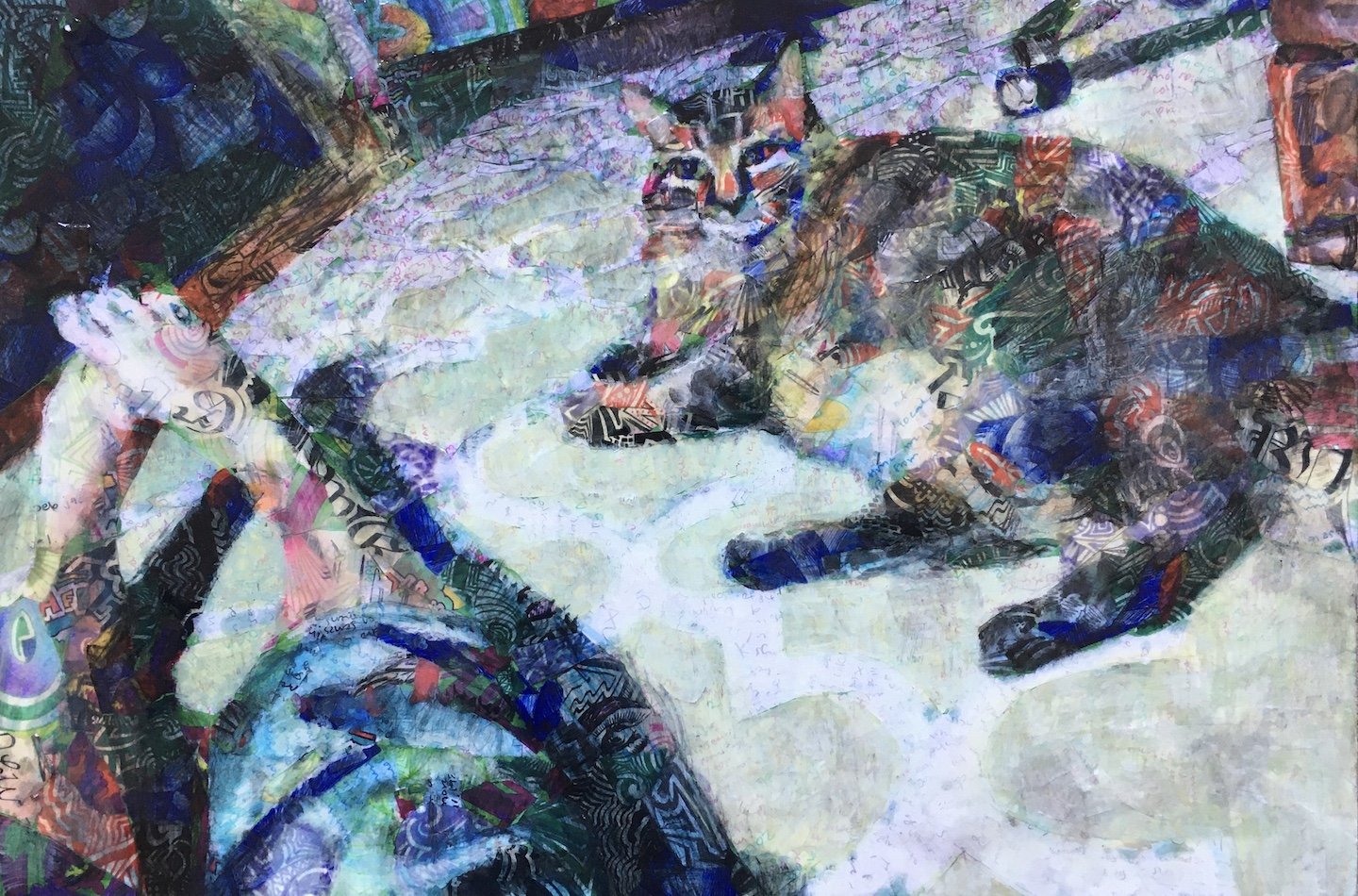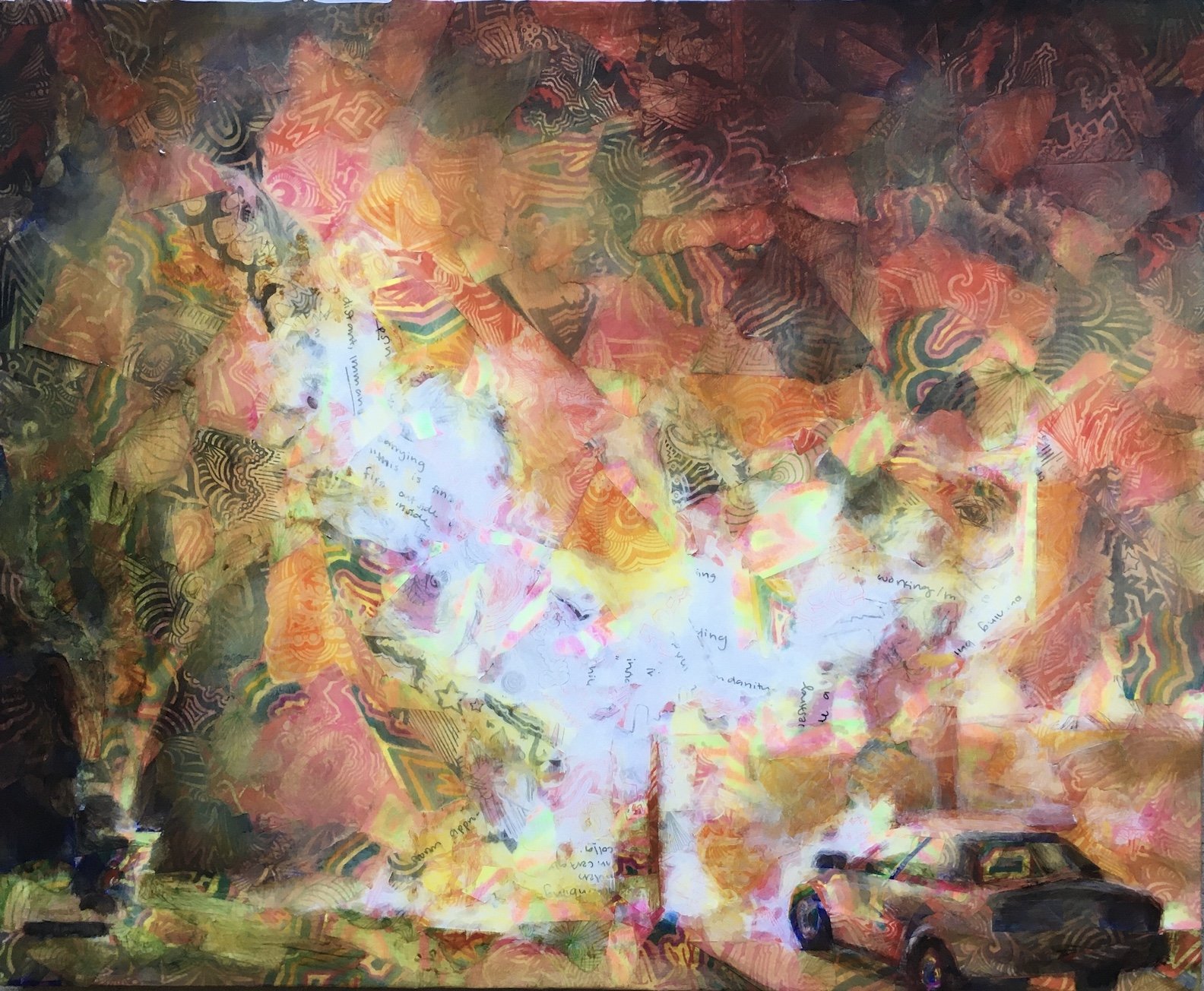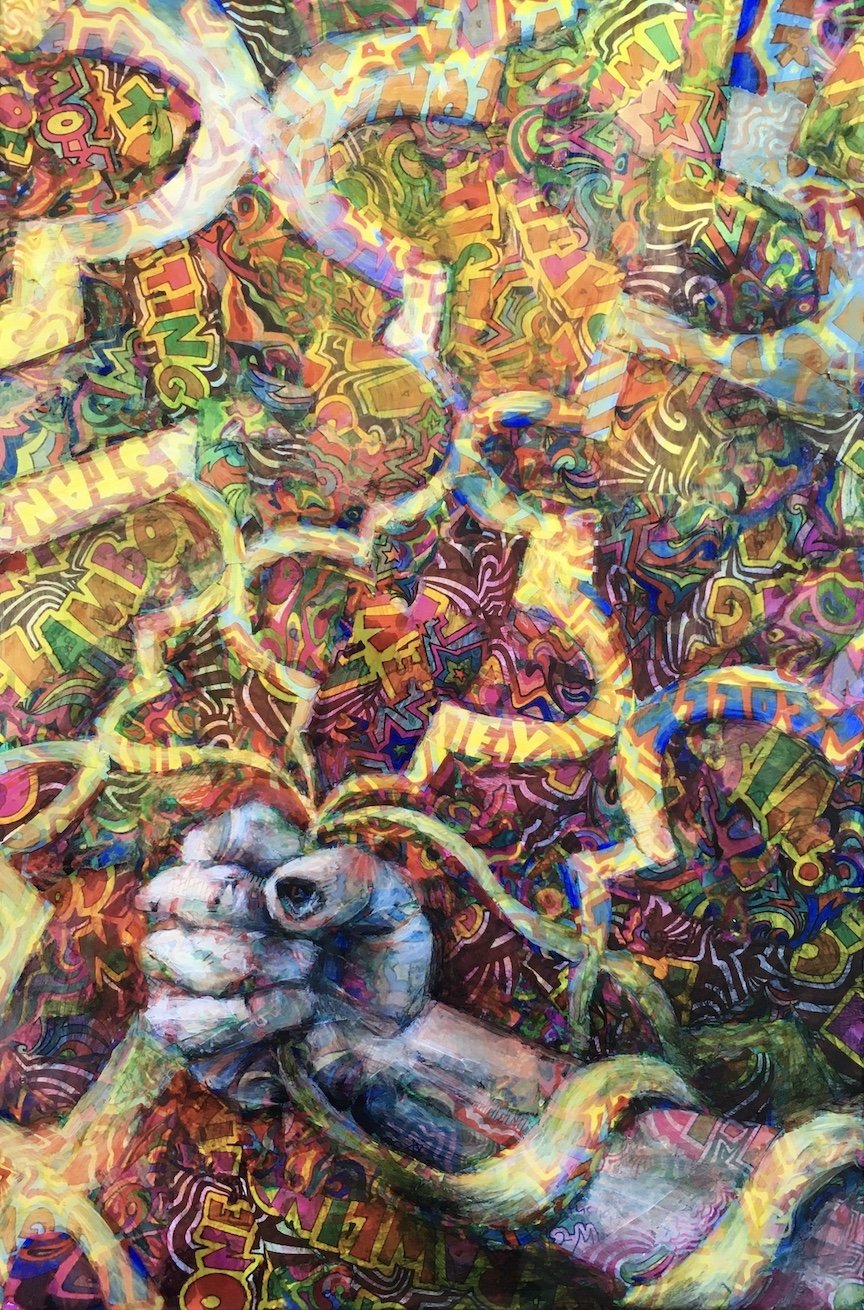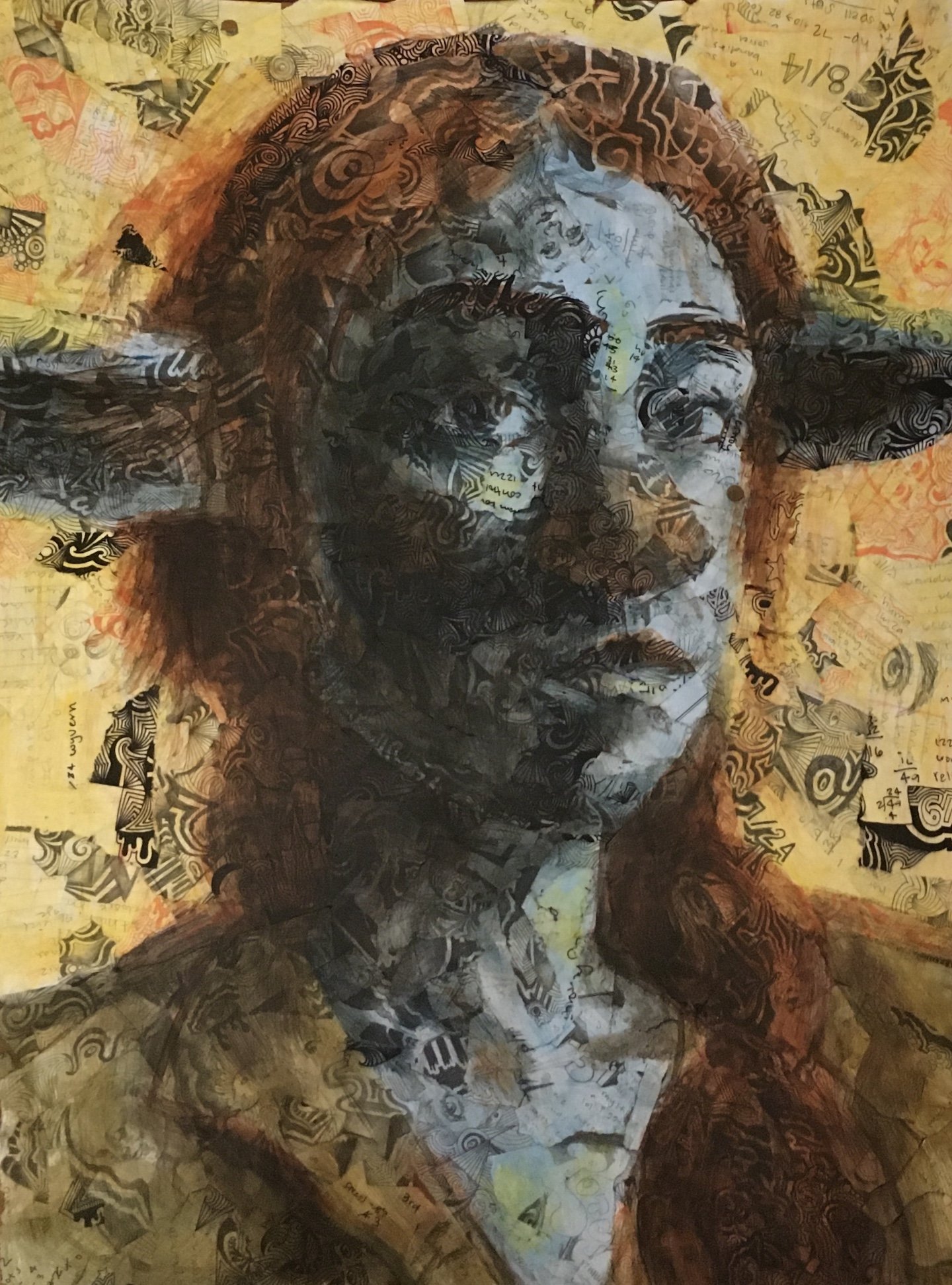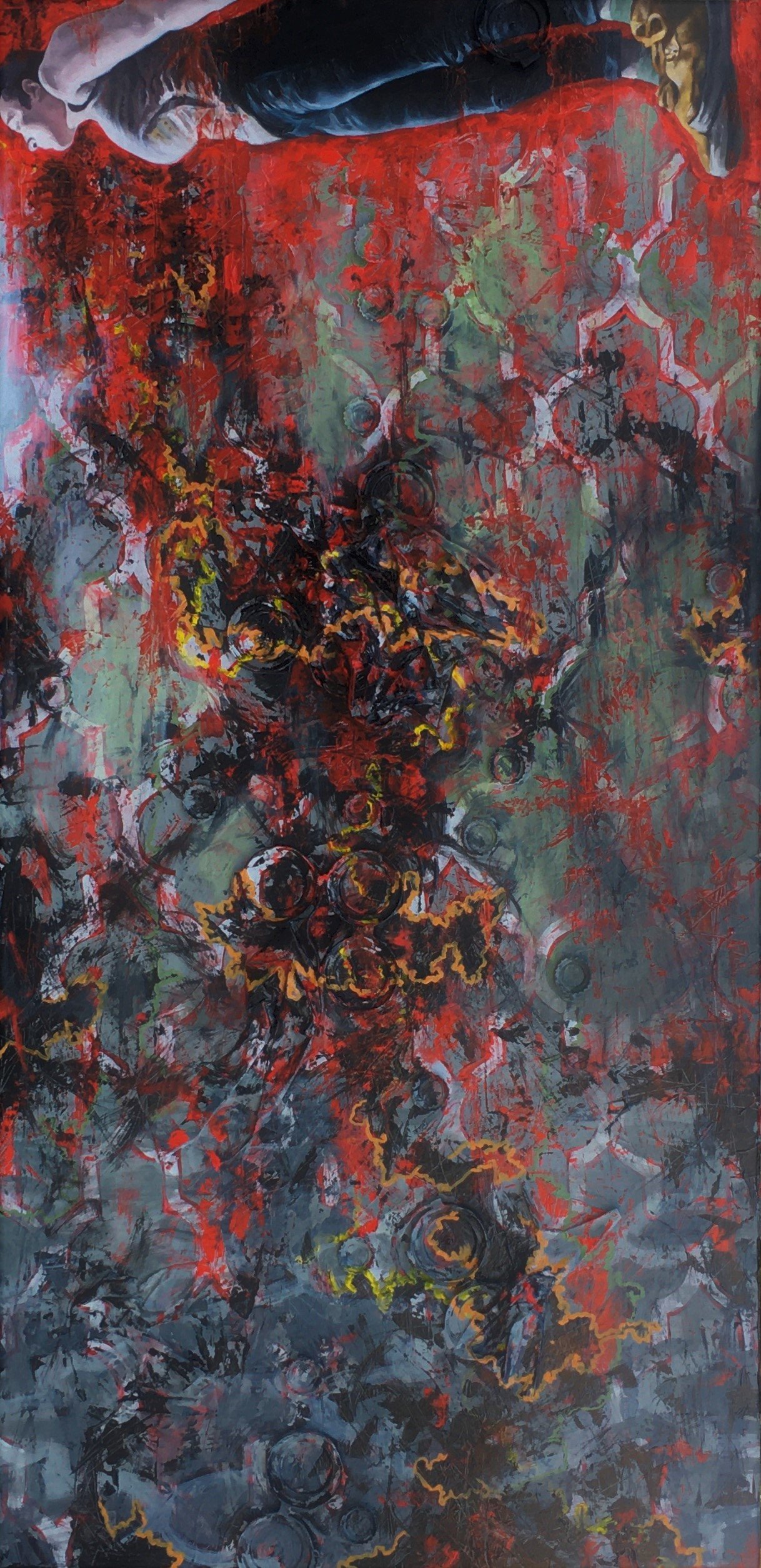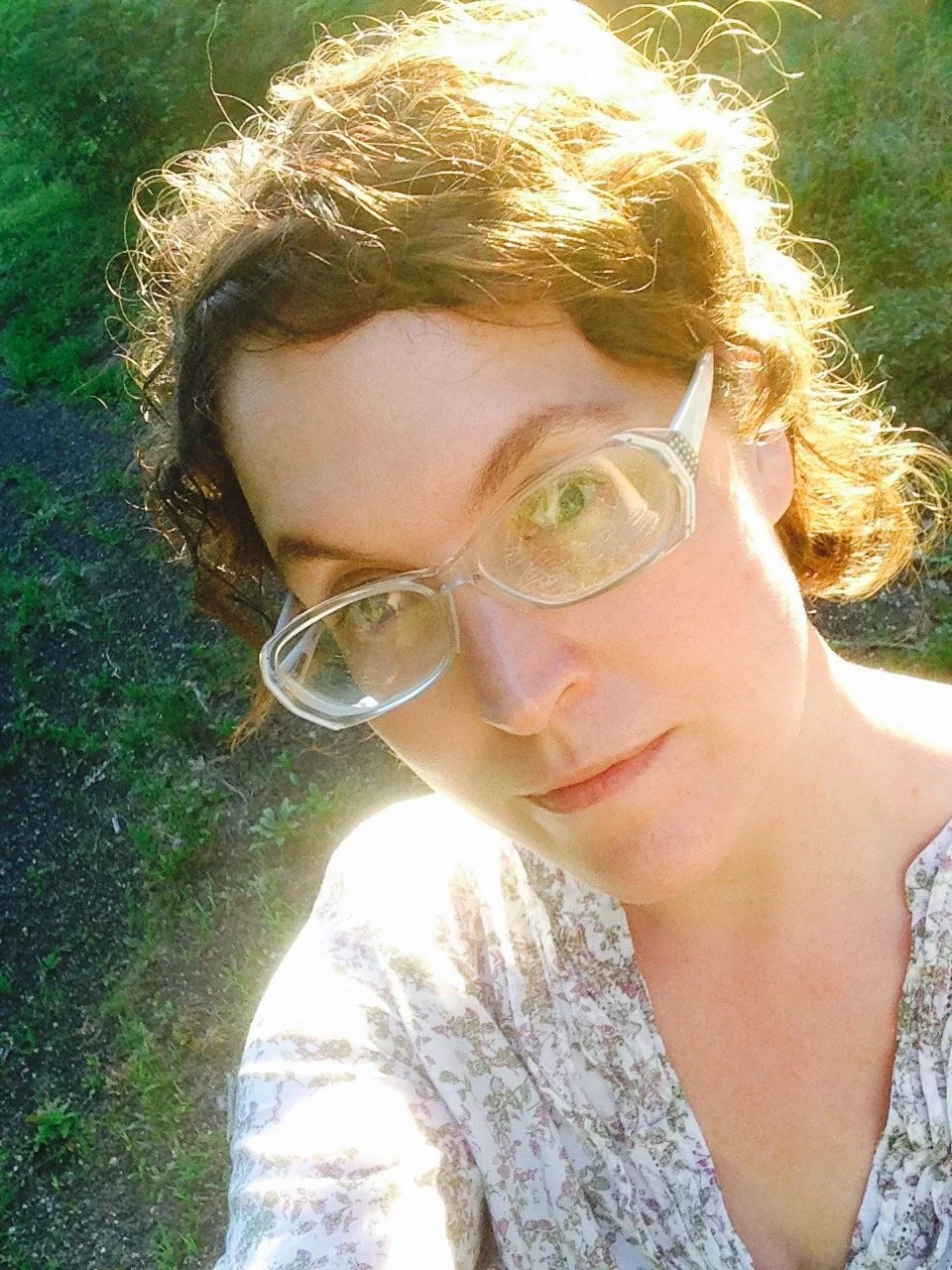Interview with artist Sarah Lassiter
Sarah Lassiter is an artist living and working in Little Rock. A recent MA graduate from the University of Arkansas at Little Rock, her thesis paintings reflect those time and are deeply personal. Her most recent works include collages, which are an explosion of color and pattern and unique storytelling. More of Sarah’s work can be seen at M2 Gallery in Little Rock, where it will be featured in the September M2 EXP show.
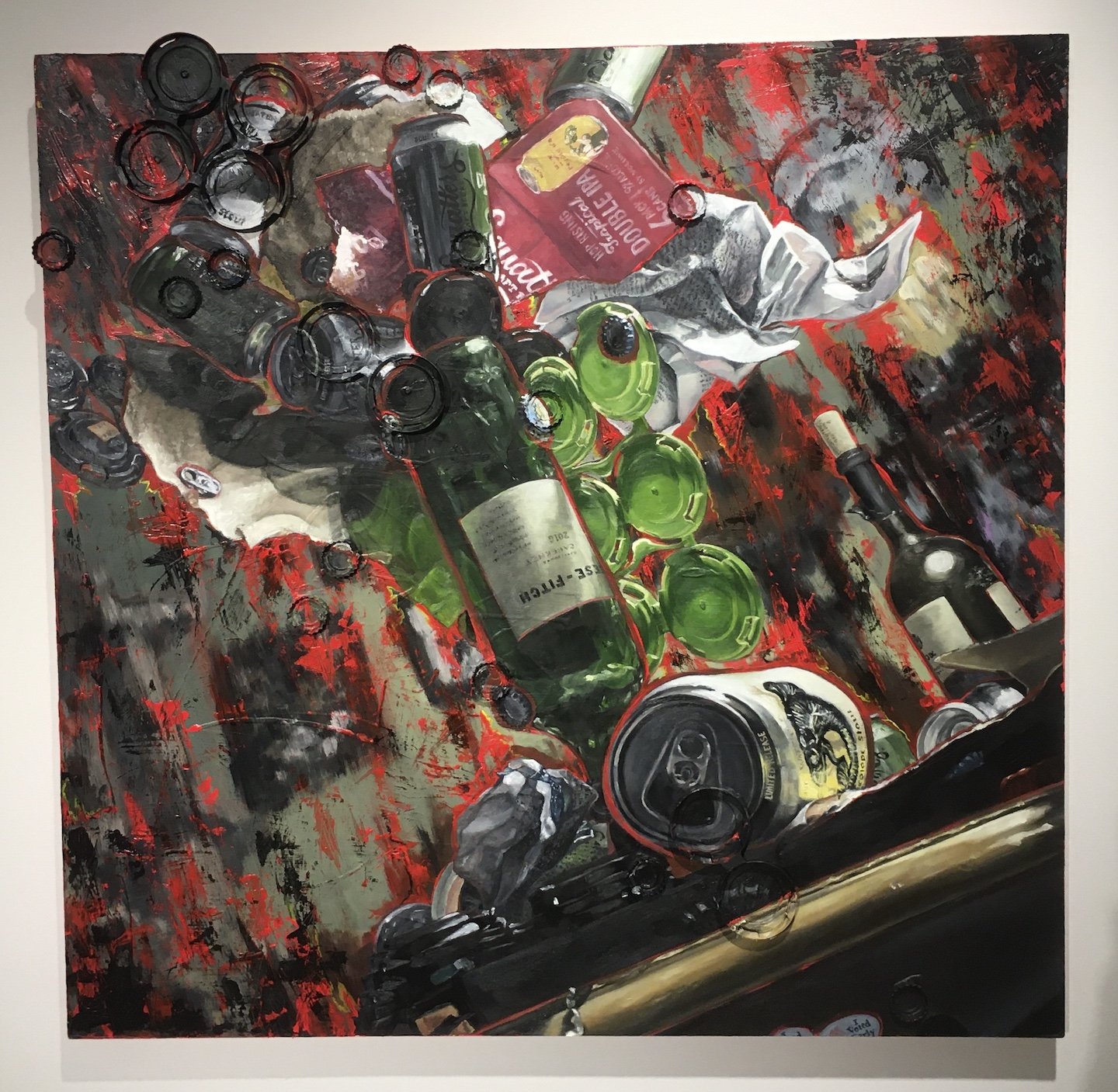
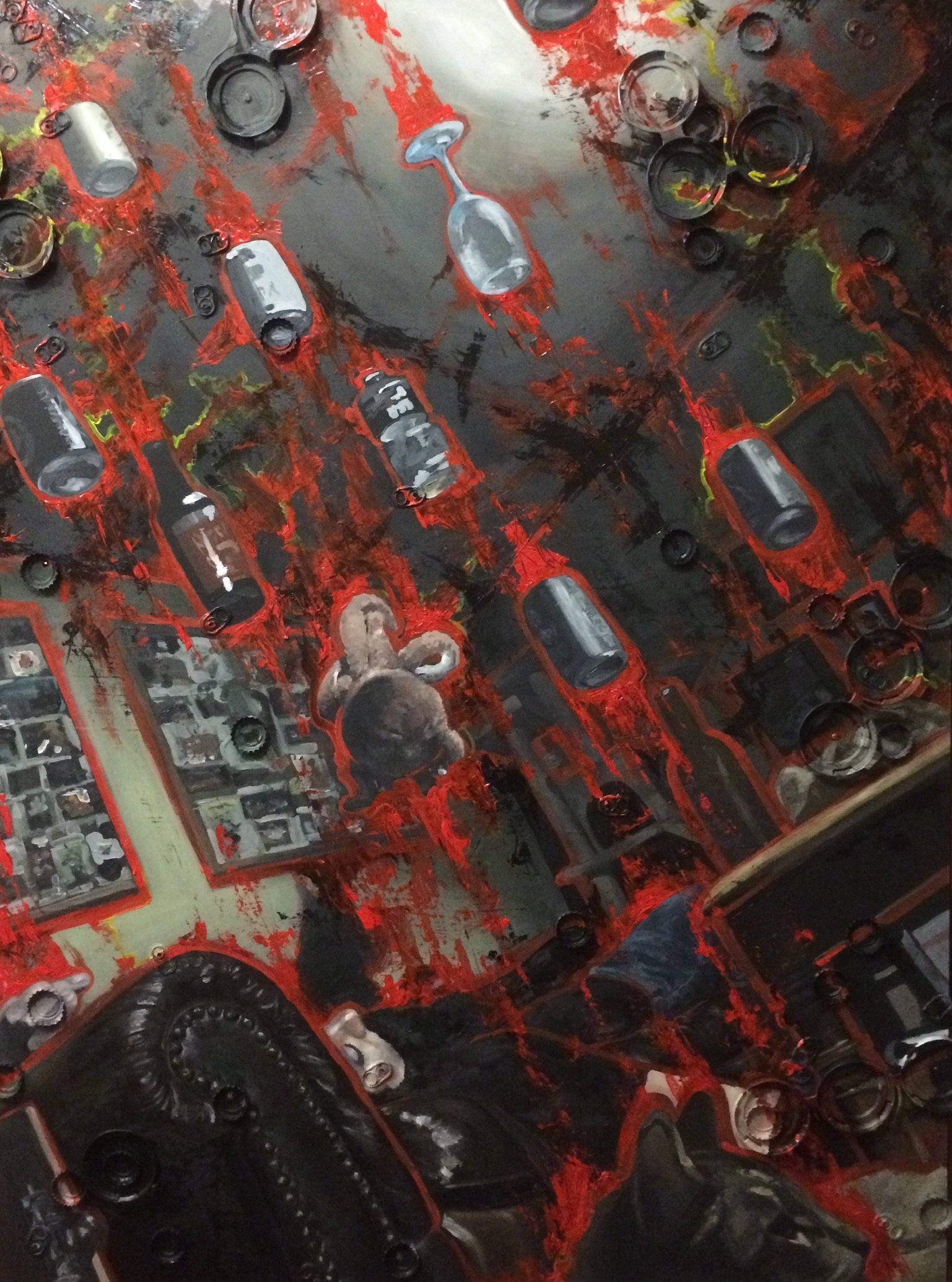
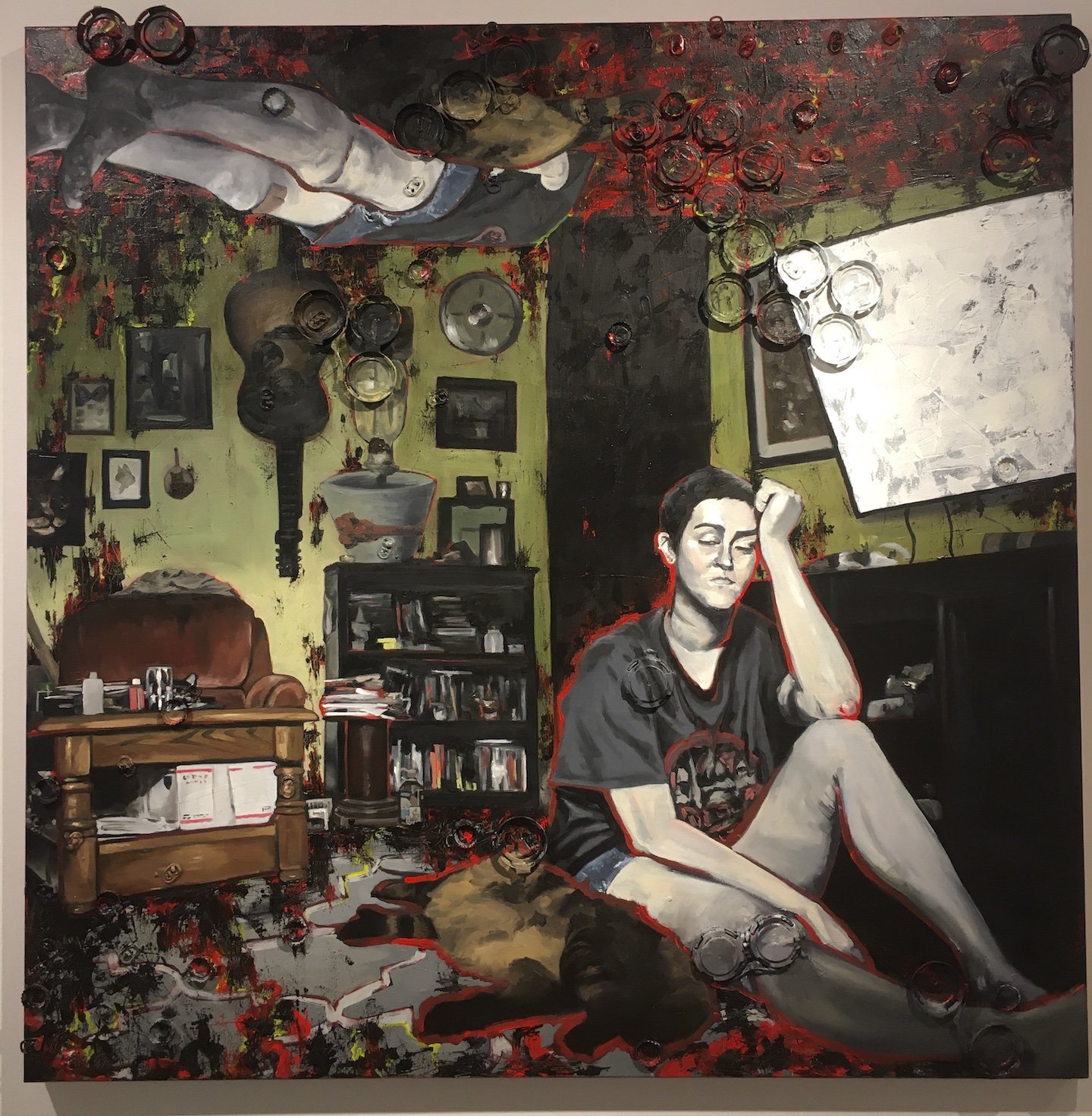
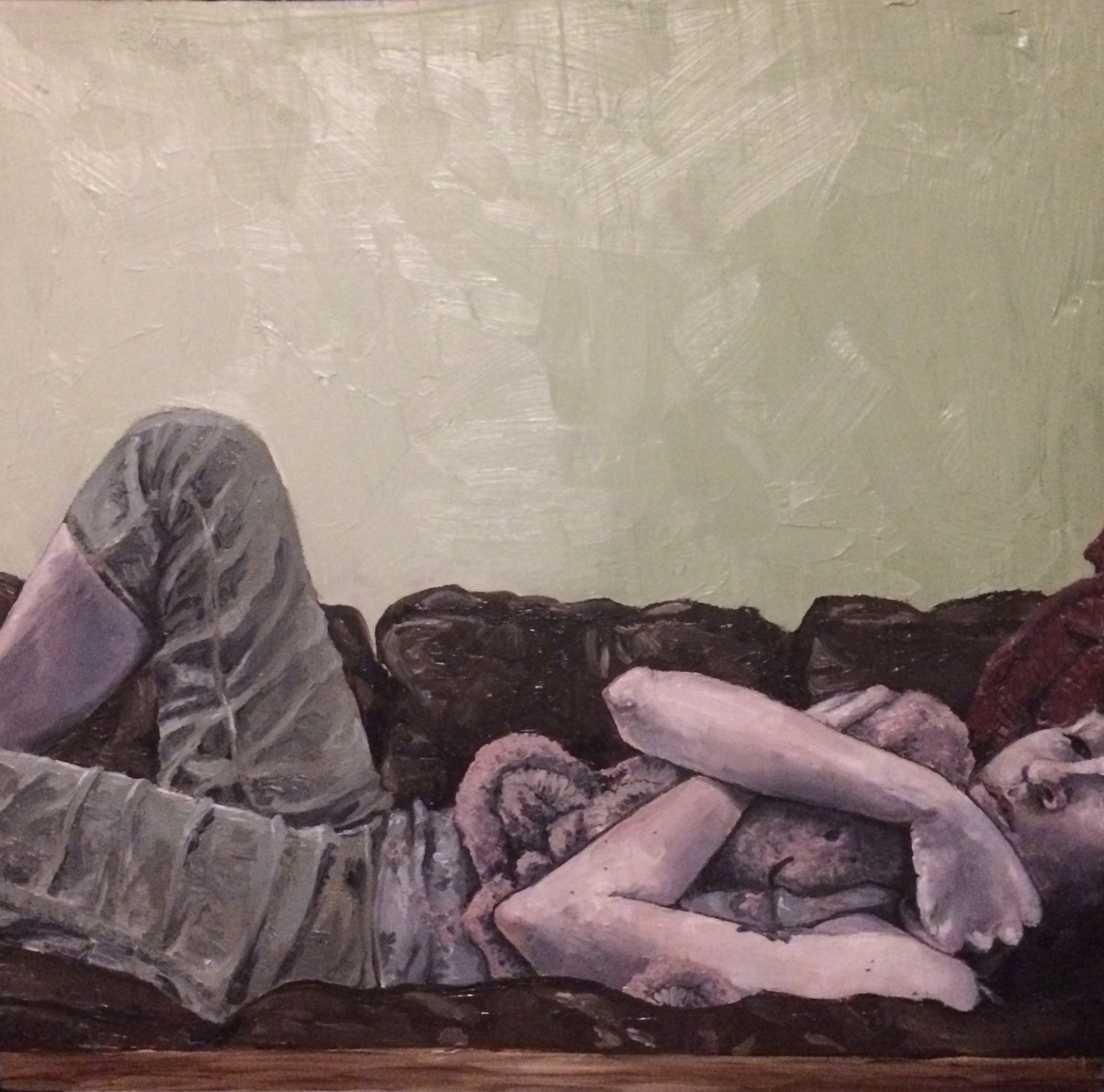
AAS: Sarah, tell me about yourself. Are you originally from Little Rock?
SL: I’m a Little Rock native but I’ve lived in other parts of Arkansas and upstate New York. I’m a UA Little Rock alum and I recently earned my Master’s in Visual Arts with a painting emphasis. My Bachelor’s degrees are in Psychology and Philosophy. Being a working studio artist has been my dream since childhood, so since graduation, I’ve just been chipping away at it. I work part time at a children’s store in the Heights and spend as much time as I can in the studio. Reading and walking are also helpful to my art practice. That combination of spending time with fresh perspectives and having time set aside for reflection gives me an opportunity to mull over different inspirations and ideas I can then bring to my art-making.
AAS: You studied psychology and philosophy. Why those subjects? Have they helped you in some way to tell your story through your art?
SL: Those were just the things I was most curious about. At a pretty young age, I realized that I was a materialist, and I encountered a lot of people who told me that accepting materialism meant I had to also accept some sort of moral nihilism and abandon any system of meaning. When I got to college, I was basically out to prove these people wrong. I was drawn to psychology because I wanted to better understand the mechanisms of experience and decision-making. I didn’t mean to get a philosophy degree. I just kept taking philosophy classes when I had gaps in my schedule because I enjoyed them and accumulated so many hours that I realized I may as well declare the major. Then I loved my classes on ethics and became really interested in the psychology of moral reasoning and the mechanisms of our moral intuition. If I hadn’t been so in love with what I was studying, I probably would have taken my interest in art more seriously. I actually changed my major to art when I was a sophomore but panicked and changed it back. Sometimes I feel like I’m late to the game with art, but I wouldn’t trade my earlier choices. I draw a lot of artistic inspiration from ideas from those other disciplines, and both really reinforce being thoughtful and inquisitive, which I view as good qualities for art-makers.
AAS: I first met you at your MA Thesis Solo Exhibition at UALR. It was right smack in the middle of COVID so I made an appointment to see it with you. I thought it was a terrific show that really revealed the struggles you and a lot of people at the time, were going through.
SL: Thank you, Phil! I’m so glad you were able see it. It was a ton of work, but I was proud of the way it turned out. I began to work on Suspension in the beginning of 2020. I was thinking about using the series to explore the way all the destabilizing current events make it difficult for people to project themselves into the future, and the halting, almost paralytic effect that type of anxiety can have. I used elements like immobilized figures, built-up clutter, aggressive mark-making, and an intense color palette to try to create the connection between the intensity of these anxieties and the stillness that can result. Initially, I was thinking about things like climate change, extreme inequality, and the unraveling of our politics, but then, of course, COVID hit. The vague, looming threats were hijacked by this new, more immediate threat. The effects of the pandemic were felt unevenly for different people, but because we were all experiencing some version of its turbulence, the series became something that was more relatable and more people really understood that counterintuitive link between chaos and stillness. It was so gratifying to have conversations with people who felt themselves in the work and identified with its themes. Overall, it was a great experience, and everyone in the art department was so supportive. Joli Livaudais, Dr. Lynn Larsen, and Ricky Sikes went above and beyond as my committee members to provide thoughtful critique and suggestions, Nathan Larson and Brad Cushman were so generous with their help and advice about getting the show hung, and my classmates were wonderful sources of feedback and inspiration. Good things are happening in the Windgate Center for Art and Design – I definitely recommend it!
AAS: You presented several self-portraits, but two really stood out to me – Shadow Self and Figure With Bright Light. I saw them as depicting someone trapped by the times but with a way out they just couldn’t or were afraid to use. What were you wanting to tell in those paintings?
SL: I was definitely trying to communicate that feeling of stagnation or immobility. With all the instability in the world, it can be hard to envision the future. If you can’t imagine the future, it can be hard to move toward a goal, or to move at all. I wanted to use the bright white light to convey the idea of one’s sense of possibility being obscured. The wrought iron bars on the storm door suggest a sense of imprisonment as well. But of course, the figures could turn around and shatter their perception of being trapped. There’s an artificiality to this confinement because its source is psychological. I think I was trying to get at the way the psychological harm people sustain from the overwhelming uncertainty of our times has a subtlety to it. These anxieties can have real effects and create real harm, even if it’s technically possible to overcome them or the harms are hard to see and measure.
Shadowy Self, 36” x 24”, oil on panel
Figure With Bright Light, 72” x 36”, oil on panel with found objects
AAS: You know my favorite from the show was Unrest. Another bright-light escapeless scene. Tell me about that piece and its story.
SL: Unrest was the first immobilized figure I painted for this series. I wanted to convey a sense of unnatural stillness with these stunted figures, and I spent a lot of time looking at Gregory Crewdson’s photography and Wayne Thiebaud’s painting Supine Woman for inspiration. Both of these artists really succeed in using motionless figures to create an atmosphere that is tense and unnerving, but also very quiet. When I depicted my partner, Trystan, in Unrest, I used a lower angle to give the painting a slightly odd perspective, and the figure is out-of-place in his jacket and work boots. He looks like he’s supposed to be outside, or at least not sitting frozen on the floor. His expression is blank, and like many of the other paintings in the series, aggressive red and black marks ooze into the scene, meant to convey the way the relevant anxieties are invasive and insidious.
Unrest, 24” x 36”, oil on canvas
AAS: As you said, the paintings in the Suspension series used an aggressive style and color palette. Tell me more about those choices and how you used color to create that feeling and mood.
SL: The color palette was really fun to work with, it’s just so moody and dissonant with lots of cadmium red, black, and pastel green. There’s a lot of contrast between the red and green and the pure and mixed colors. I wanted the red and black to creep into the environments and feel really intense, invasive, and have an overpowering quality. The green is a shade of the paint in my living room, which appears in a lot of these paintings. The red and black are often applied aggressively with a palette knife, I wanted it to feel kind of violent. The combination of the quiet and loud, both in individual paintings and in the series as a whole, was important to the dissonance I was trying to explore. Like- the whole world is on fire and I’m just stuck in my living room watching the light change on my ceiling.
AAS: Most recently, you have been creating collages in a different color palette. Tell me about Collision. Did you pull elements from Figure With Bright Light?
Collision, 24” x 24”, mixed media collage
SL: I may make a few more paintings to add to Suspension, but the themes are so heavy, and I wanted to do something somewhat related but a little less intense. I recently came across The Yellow Wallpaper, the 1892 short story by Charlotte Perkins Gilman. It’s about a woman who is taken to an isolated house in the countryside by her well-intentioned but not-listening husband, where he thinks she needs to rest and recover from her vague malaise. Without much else to do, she spends hours studying the horrible yellow wallpaper in her bedroom, which she becomes obsessed with. It tortures her with its unruly pattern, and over time she begins to see things moving in the pattern, figures trapped inside. Eventually she devolves into insanity. The story immediately grabbed me, and the themes of stillness and madness in the story felt like such a natural way to branch out from my previous series, plus I thought it would be fun to work with such a classic piece of fiction. So, my current project is a series of collages loosely based on The Yellow Wallpaper and ways it is still relevant today. You mentioned the color palette, and honestly, I love that the wallpaper in the story is yellow. It’s one of my favorite colors, and it’s been really fun to give yellow and other warmer, happy colors a little bit of a sinister edge. In Collision, I wanted to make something that mimics the teeming effect of the wallpaper in the story. Relating the character’s trapped mentality to the ideas of confinement in Suspension, I wanted to use some of the patterns I myself had spent too much time studying. The pattern of the wrought iron storm door is merged with the Moroccan pattern from the carpet, which are both present in Figure with Bright Light and other paintings in from Suspension. In Collision, the viewer can spend time trying to make sense of the collage as a whole, try to untangle the patterns superimposed on each other, or try to make out the pieces of drawings composing the collage itself.
AAS: How do you create these collages?
SL: I’m super excited about the collages. They’re really fun to make and I love how different they are. I’ve always liked drawing, and when I was about 13, I started filling notebooks with doodles. They are mostly abstract sharpie drawings, but they vary. I make the doodles all the time, I like them, and I’ve amassed SO many of them over the years, but they don’t feel quite serious enough to share on their own. I had been really unsure about how I might incorporate them into my more serious art practice until I had the idea that it might be neat to collage them. For the collages, I sketch out the composition on a panel, then I cut and tear the doodles into the shapes I need and start to glue them down piece by piece to establish the values and shapes. The line density, color, temperature, and drawing medium of the doodles all need to be considered when deciding where the cut pieces go or the final image won’t read correctly. When everything is glued down and the values and shapes look right, I go in with transparent glazes of acrylic paint to accentuate the color, and the final step is to coat the surface with epoxy resin to give a more even surface. Many of the doodles I’m using are things I already have, but for some things, I create new drawings to use that relate to the subject matter of the collage. For example, I created a lot of new doodles with characters and quotes from The Yellow Wallpaper for works like Collision and Nightbitch. I love that the actual words of the story are being incorporated. There are so many little hidden secrets and clues for people to discover in these!
AAS: Tell me more about Nightbitch.
Nightbitch, 26” x 20”, mixed media collage
SL: Nightbitch is inspired by Rachel Yoder’s 2021 novel by the same name, and is actually where I was inspired to read The Yellow Wallpaper. Nightbitch tells the story of a woman who starts to lose her grip when her husband leaves her alone with their toddler for long stretches of time as he endlessly travels for work. The Sisyphean mundanity of the housewife lifestyle, the loss of her career and autonomy, and the thankless exhaustion of motherhood are a few of the factors that chip away at her sanity, as she begins her literal transformation into a dog. The plotline of Nightbitch echoes Gilman with the descent into madness caused by misogynistic structures in the environment, and Yoder’s protagonist even talks about having read the short story, comparing herself to Gilman’s character. It was really fun to put quotes and drawings from The Yellow Wallpaper into a collage based on a novel that nods to it. I think it’s so cool to have different feminist creative works all interacting with and building on each other, across different mediums and spanning time. And it was neat to be able to show Rachel Yoder a creative work she inspired!
AAS: Collaged Window Figure is a different depiction of Trystan than in Unrest. Here he seems to be saying, “I’m good. I don’t need a way out.” I just love the composition and the shading effects.
Collaged Window Figure, 36” x 24, mixed media collage
SL: To be super honest, I don’t know what Trystan is thinking in this one! It was important to me to depict him in a still, somewhat somber state, backlit with the bright window, but I tried to leave his expression neutral and blank. With the immobilized figures, there is a lot of emphasis on negation, what they aren’t imagining, what they aren’t doing, things they can’t see, things that have been stolen from them. The viewer is left to wonder what might fill those voids. Some of the paintings in Suspension explore the dysfunctional coping I personally have leaned on when the future has felt unimaginable, but it’s not my intention to project that onto anyone else. And hey- shoutout to Trystan for being a patient and cooperative muse!
AAS: Where do you think your current collage work will take you?
SL: With the collages, I’d like to finish the series inspired by The Yellow Wallpaper, and I want to play with using this method for portraiture. That doesn’t mean I have to stop painting, though! Variety keeps things fresh and makes it harder to burn out. Painting people, animals, and landscapes will be breaths of fresh air when I get tired of picking up the tiny pieces of doodle-confetti that end up everywhere when I’m collaging.
AAS: Do you have any advice for young artists just starting out or thinking about becoming a serious artist?
SL: First and foremost, be honest about what you want. It was weirdly difficult for me to admit that I wanted to pursue art- I just felt really vulnerable putting my intentions out there. But if art is something you want, you’ve got to shrug off the insecurity and not worry about whether you’re valid as a “real artist”. An artist is just a person who makes art. And don’t fall for the myth of talent. It’s all practice, so just put the work in and trust the process. Embrace criticism, be teachable, and don’t take things too personally. It’s important to keep the art attached to the joy of making, so be sure you actually like what you’re making and that you’re internally motivated. Know you will have moments of doubt, so don’t be embarrassed to give yourself pep talks. It feels cheesy but it really does help, and being discouraged isn’t going to help you keep moving and making the work. When parts of your art journey are stressful, try to recontextualize it in terms of gratitude. Remember that these art-related stresses mean you’re fortunate, and that you’re grateful to be on this path moving toward something you love.
